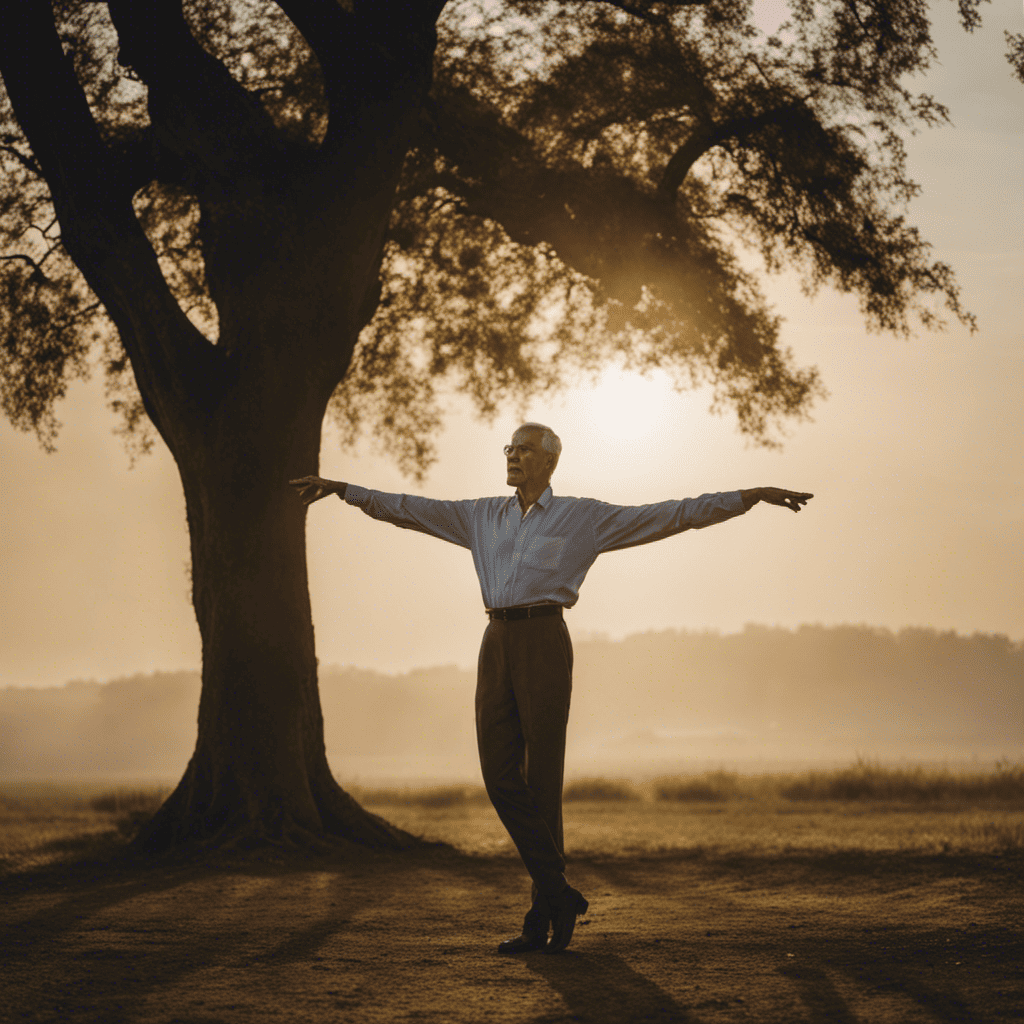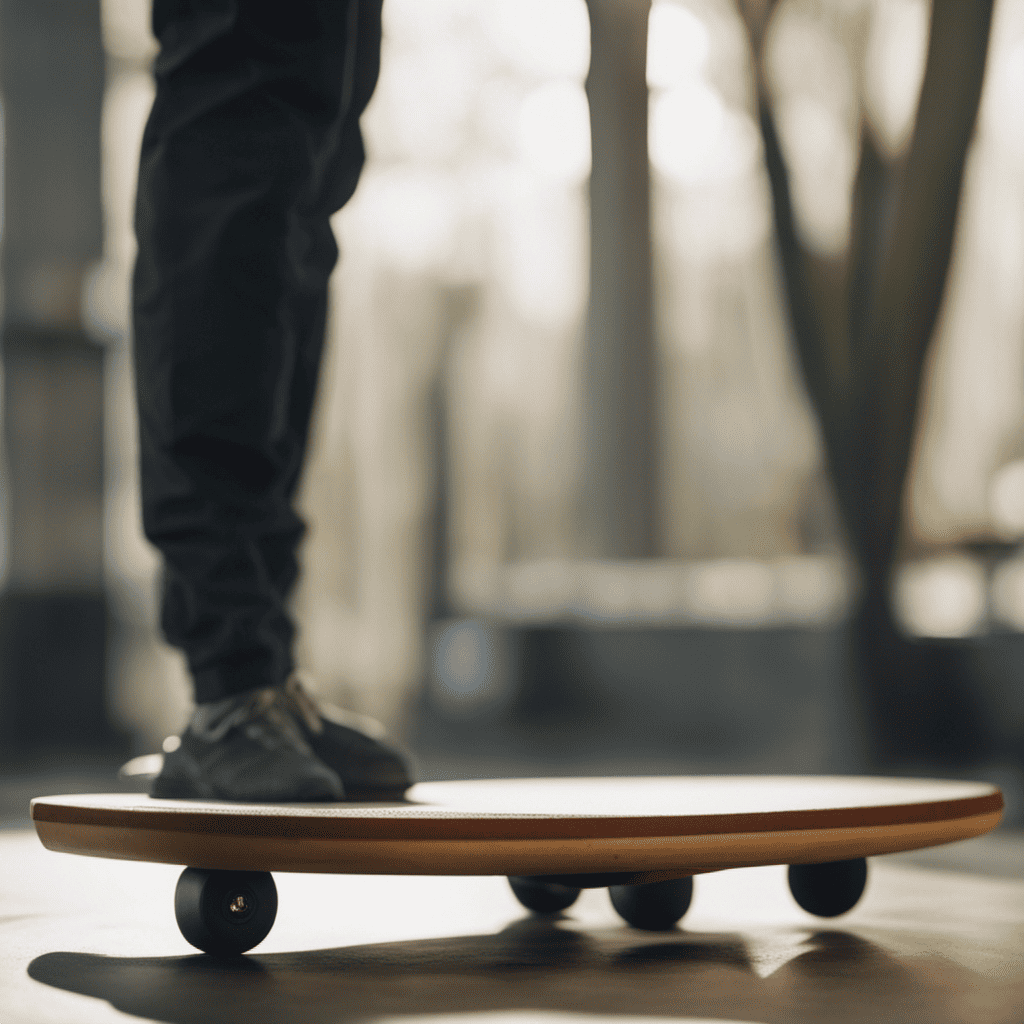Imagine feeling confident and steady on your feet as you navigate through life’s adventures. With age, maintaining balance becomes even more crucial to prevent falls and injuries.
But don’t worry, there’s good news! By incorporating simple and effective balance exercises into your routine, you can enhance your stability, agility, and body awareness.
In this article, we’ll guide you through a variety of exercises that will help you stay grounded, strong, and independent as you age.
Let’s get started on your journey towards better balance!
Key Takeaways

- Strengthening exercises for balance are important to incorporate into your routine to improve coordination and target various muscle groups.
- Dynamic balance exercises can improve agility and stability by engaging core muscles, improving coordination, and enhancing proprioception.
- Core stability exercises are key for balance enhancement and can strengthen muscles in the abdomen, back, and pelvis to provide stability and support.
- Proprioceptive exercises can improve body awareness and balance by challenging your balance, enhancing stability, and preventing falls.
Strengthening Exercises for Improved Balance
You can try these strengthening exercises to improve your balance. Improving coordination and balance training benefits are crucial for maintaining stability and reducing the risk of falls, especially as you age. These exercises target various muscle groups that contribute to balance and stability, helping you feel more secure on your feet.
One effective exercise is the single-leg stance. Stand near a wall or sturdy chair for support, then lift one leg off the ground and hold for 30 seconds. Repeat on the other leg. This exercise challenges your balance and strengthens the muscles in your lower body.
Another exercise is heel-to-toe walk. Find a straight line on the ground and walk along it, placing the heel of one foot directly in front of the toes of the other foot with each step. This exercise improves coordination and challenges your balance.
Additionally, consider incorporating squats into your routine. Stand with your feet shoulder-width apart, then slowly lower your body as if you’re sitting back into a chair. Keep your weight in your heels and your knees aligned with your toes. Squats strengthen your leg muscles, which are vital for maintaining balance.
Remember to start slowly and gradually increase the difficulty of these exercises as your balance improves. Consistency is key when it comes to strengthening your balance, so try to incorporate these exercises into your daily routine.
Dynamic Balance Exercises for Agility and Stability

Try incorporating dynamic balance exercises into your routine to improve agility and stability. Agility training and balance drills are essential for maintaining a strong and stable body as you age. These exercises not only help you to prevent falls but also enhance your overall physical performance.
Dynamic balance exercises involve movements that challenge your body’s ability to maintain stability while in motion. They require you to engage your core muscles, improve coordination, and enhance proprioception. Proprioception is your body’s ability to sense its position in space, which is crucial for maintaining balance.
One example of a dynamic balance exercise is the single-leg deadlift. This exercise targets your glutes, hamstrings, and core muscles while also improving your balance. Stand on one leg and hinge forward at the hips, extending the opposite leg behind you for balance. Keep your back straight and engage your core as you lower your upper body towards the ground. Return to the starting position and repeat on the other leg.
Other dynamic balance exercises include lateral lunges, single-leg squats, and standing knee raises. These exercises challenge your stability in different ways and help to develop strength and agility.
Incorporating these exercises into your routine can improve your overall balance and reduce the risk of falls, allowing you to maintain an active and independent lifestyle as you age.
Core Stability Exercises to Enhance Balance
To enhance your balance, core stability exercises are key.
These exercises focus on strengthening the muscles in your abdomen, back, and pelvis, which play a crucial role in maintaining your balance and stability.
Importance of Core Stability
Engage your abdominal muscles during these core stability exercises to improve your balance. Core strength plays a crucial role in maintaining overall health and preventing injuries. When your core muscles are strong, they provide stability and support to your spine, pelvis, and hips, allowing for better balance and coordination. This is especially important as we age, as falls can result in serious injuries.
Core stability exercises target the muscles deep within your abdomen, such as the transverse abdominis and the obliques, which help stabilize your spine and maintain proper posture. By incorporating exercises like planks, Russian twists, and bird dogs into your routine, you can enhance your core strength and improve your overall stability.
Effective Balance-Enhancing Exercises
You can incorporate three simple balance-enhancing exercises into your routine: single-leg stands, heel-to-toe walks, and side leg raises. These exercises help strengthen your muscles and improve your core stability, which is crucial for maintaining balance as you age.
Single-leg stands involve standing on one leg for a certain amount of time, gradually increasing the duration as you get stronger.
Heel-to-toe walks require you to walk in a straight line, placing the heel of one foot directly in front of the toe of the other.
Side leg raises involve lifting one leg out to the side while maintaining good posture.
Proprioceptive Exercises for Body Awareness and Balance

If you want to improve your body awareness and balance, try incorporating proprioceptive exercises into your fitness routine. Proprioception refers to the ability to sense the position and movement of your body in space, and it plays a crucial role in maintaining proper body alignment and executing balance training techniques. By focusing on proprioception, you can enhance your body’s ability to maintain stability and prevent falls.
Here are some proprioceptive exercises that you can try:
-
Single-leg balance: Stand on one leg and hold the position for as long as you can. This exercise challenges your balance and strengthens the muscles in your legs and core.
-
Wobble board exercises: Use a wobble board or balance disc to perform various movements, such as shifting your weight from side to side or rotating your hips. These exercises improve your body’s ability to adapt to different surfaces and movements.
-
Proprioceptive lunges: Perform lunges while holding a weight or medicine ball. As you lunge, focus on maintaining your balance and proper body alignment.
-
Yoga and Pilates: These practices incorporate a range of proprioceptive exercises that improve body awareness, balance, and flexibility.
By incorporating these exercises into your fitness routine, you can enhance your body awareness and balance, reducing the risk of falls as you age.
Now, let’s explore balance exercises using stability equipment to further challenge your proprioception and balance skills.
Balance Exercises Using Stability Equipment
To challenge your balance and improve your proprioception, try incorporating stability equipment such as a balance ball or Bosu ball into your balance exercises. Stability ball exercises are a great way to engage your core muscles and improve your stability. You can start by sitting on the stability ball and gradually progress to more challenging exercises like plank holds or single-leg squats. These exercises not only help improve your balance but also strengthen your muscles.
Balance beam exercises are another effective way to enhance your balance. You can use a balance beam or create your own makeshift beam using a long, narrow board placed on the ground. Walking heel to toe along the beam can help develop your balance and coordination. As you become more comfortable, you can try walking backward or adding small jumps to increase the difficulty level.
Incorporating stability equipment into your balance exercises not only adds variety but also helps you develop better balance skills. By challenging your body in different ways, you train your muscles to respond to different stimuli, improving your overall balance and stability.
Now that you have learned about stability ball and balance beam exercises, let’s move on to functional balance exercises for everyday activities.
Functional Balance Exercises for Everyday Activities

To improve your balance for everyday activities, you can try chair-based balance exercises that focus on strengthening your core and legs. These exercises involve sitting on a stable chair and performing movements that challenge your balance, such as lifting one leg or reaching for objects.
Additionally, standing balance drills like standing on one leg or walking heel to toe can help improve your stability and coordination.
Chair-Based Balance Exercises
You should start incorporating chair-based balance exercises into your daily routine to improve your stability and prevent falls. These exercises are specifically designed to help you maintain your balance while sitting, and they offer several benefits.
Here are some reasons why you should consider adding chair-based balance exercises to your routine:
- They can help improve your posture and alignment.
- They can strengthen the muscles in your core, lower back, and legs.
- They can enhance your coordination and body awareness.
- They can increase your confidence and independence in daily activities.
By regularly practicing these exercises, you won’t only improve your balance while sitting but also enhance your overall stability and reduce the risk of falls.
Once you have mastered chair-based exercises, you can gradually progress to standing balance drills to further challenge your stability and continue your journey towards better balance.
Standing Balance Drills
Try incorporating standing balance drills into your daily routine for improved stability and reduced risk of falls during everyday activities.
As we age, our balance tends to decline, making us more susceptible to falls that can result in serious injuries. By engaging in regular balance exercises for seniors, you can strengthen the muscles in your legs and core, which are essential for maintaining stability.
A balance training program can include exercises such as standing on one leg, heel-to-toe walking, and side leg lifts. These drills challenge your body’s balance mechanisms, improving your proprioception and coordination.
Additionally, practicing these exercises regularly can enhance your confidence and independence, allowing you to engage in daily tasks with ease.
Remember to consult with a healthcare professional before starting any new exercise program.
Together, let’s prioritize our balance and prevent falls as we age.
Balance While Multitasking
Maintaining balance while multitasking can be challenging, but practicing functional balance exercises can help improve your stability and coordination. It’s important to prioritize balance training, as it plays a crucial role in preventing falls and injuries, especially as you age.
Whether you’re walking or engaging in sports activities, here are some exercises that can enhance your balance:
-
Single-leg stance: Stand on one leg for 30 seconds, gradually increasing the duration as you build strength and stability.
-
Heel-to-toe walk: Take small steps, placing your heel directly in front of the toes of your opposite foot. This exercise mimics the motion of walking a tightrope and improves balance while walking.
-
Standing leg swings: Stand upright and swing one leg forward and backward, maintaining good posture and engaging your core.
-
Side leg lifts: Stand with feet together and lift one leg out to the side, then lower it back down. This exercise targets the muscles responsible for balance during sports activities.
Incorporating these exercises into your routine can help you achieve better balance and reduce the risk of falls, allowing you to confidently navigate daily activities and enjoy your favorite sports.
Conclusion
In conclusion, incorporating balance exercises into your daily routine can greatly improve your stability and prevent falls as you age.
By engaging in strengthening exercises, dynamic movements, core stability training, proprioceptive exercises, and using stability equipment, you can enhance your body’s awareness and maintain better balance.
Remember, balance is like a tightrope – it requires practice and focus, but the rewards are worth it.
So, take the necessary steps to keep your balance in check and stay steady on your feet.
As a veteran fitness technology innovator and the founder of GearUpToFit.com, Alex Papaioannou stands at the intersection of health science and artificial intelligence. With over a decade of specialized experience in digital wellness solutions, he’s transforming how people approach their fitness journey through data-driven methodologies.
